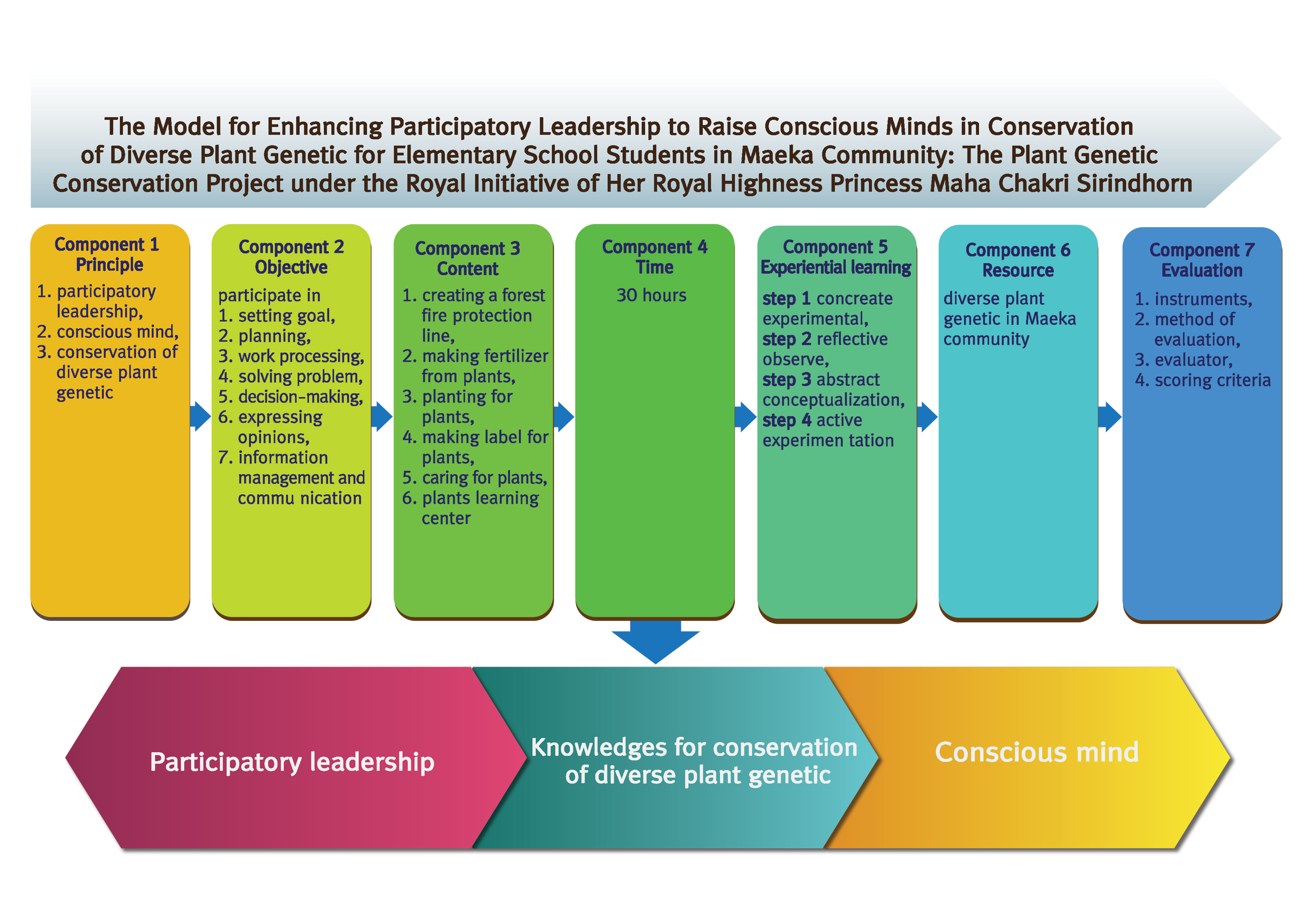The Model for Enhancing Participatory Leadership to Raise Conscious Minds in Conservation of Diverse Plant Genetic for Elementary School Students in Maeka Community: The Plant Genetic Conservation Project under the Royal Initiative of Her Royal Highness Princess Maha Chakri Sirindhorn
Main Article Content
Abstract
The main objective was responding to the royal initiative of The Plant Genetic Conservation Project under the Royal Initiative of Her Royal Highness Princess Maha Chakri Sirindhorn. The sub-objectives were as follows: synthesize the components of participatory leadership and study the needs for enhancing participatory leadership, develop the model, implement, and analyze the success factors and problems after utilizing the model. The population consisted of 468 elementary school students in the Meaka community. The samples were 74 elementary school students of Banhuaikhian school. Instruments comprised of questionnaire, structured interview guild, participatory leadership assessment form, knowledge test for conservation of diverse plant genetics, conscious mind test, and a record form. Data were analyzed using percentages, mean, standard deviation, t-test, and content analysis.
This research found that: participatory leadership comprised of seven components. A study of the need for enhancing participatory leadership for all components were at a high level. They were arranged as follows: work processing, planning, decision-making, goal setting, expressing opinions, information management and communication, and problem-solving. The developed model comprised of seven components: principle, objective, contents, time, experiential learning activity, resources, and evaluation. The model’s propriety mean score was at the highest level. A comparison of participatory leadership mean score was at 2.80 (high level) which was higher than the criteria score of 2.50. A comparison of students’ knowledge of the conservation of diverse plant genetics before and after had a post-test mean score of 26.90 which was higher than the pre-test mean score of 7.81 (full score of 30). A comparison of the conscious mind mean score of 2.86 (high level) which was higher than the criteria score of 2.50. The success factors comprised of an experiential learning activity cycle with four steps allowed students to practice analytical thinking and a conscious mind of plants’ value and benefits. The content was consistent with the community’s needs and was useful in diverse plant genetic to remain sustainable. The problems comprised of some students learned faster than others, so, students should be encouraged to participate in helping each other in the group. The students do not know how to use certain equipment, so, should be taught basic skills first to ensure safety while organizing activities.
Article Details

This work is licensed under a Creative Commons Attribution-NonCommercial-NoDerivatives 4.0 International License.
เพื่อให้เป็นไปตามกฎหมายลิขสิทธิ์ ผู้นิพนธ์ทุกท่านต้องลงลายมือชื่อในแบบฟอร์มใบมอบลิขสิทธิ์บทความ ให้แก่วารสารฯ พร้อมกับบทความต้นฉบับที่ได้แก้ไขครั้งสุดท้าย นอกจากนี้ ผู้นิพนธ์ทุกท่านต้องยืนยันว่าบทความ ต้นฉบับที่ส่งมาตีพิมพ์นั้น ได้ส่งมาตีพิมพ์เฉพาะในวารสาร วิชาการธรรม ทรรศน์ เพียงแห่งเดียวเท่านั้น หากมีการใช้ ภาพหรือตารางของผู้นิพนธ์อื่นที่ปรากฏในสิ่งตีพิมพ์อื่นมาแล้ว ผู้นิพนธ์ต้องขออนุญาตเจ้าของลิขสิทธิ์ก่อน พร้อมทั้ง แสดงหนังสือที่ได้รับการยินยอมต่อบรรณาธิการ ก่อนที่บทความจะได้รับการตีพิมพ์References
Blake, R. R. & Mouton, T. S. (1982). A comparative analysis of situationalism and 9,9 management by principle. Organizational Dynamics, (10), 20-43.
Claremont EAP. (2004). Characteristics of a participatory leader in Impact Manager supplement. Retrieved from http://www.claremonteap.com
Delbeq, A. L. (1965). Managerial Leadership styles. UK: McGraw-Hill.
Dewey, J. (1983). Experiential and education. New York: Collier.
Donnelly, J. R. (1987). Fundamentals of management. Homewood, Illinois: Business.
Farthing, G. W. (1992). The Psychology of Consciousness. New Jersey: Prentice Hall.
Filly, A. C., House, R. J. & Kerr, S. (1976). Managerial process and organization behavior. New York: Scott and Foresman.
Flippo, E. (1966). Management: A behavioral approach. New York: Allyn & Bacom.
Green, M. F. (1988). Leader for a new era. New York: Macmillan.
House, R. J, & Mitchel, T. R. (1978). Path-goal theory of leadership. Journal of Contemporary business, 3(7), 1-97.
House, R. J. (1988). Power and personality in organizations. Connecticut: JAI Press.
Hoy, W. K. & Miskel, C. G. (1991). Educational Administrator: Theory Research and Practice. New York: McGraw-Hill.
Kolb, D. A. (1984). Experiential learning. New Jessey: Prentice-Hall.
Kuder, G. F., & Richardson, M. W. (1937). The Theory of Estimation of Test Reliability. Psychmetrika, (2), 151-160.
Likert, R. (1961). New patterns of management. New York: McGraw-Hill.
Maier, N. R. F. (1970). Problem solving discussion and conferences. New York: Wilay.
Maxwell, J. C. (2002). Developing the leader within you. Nashville: Thomas Nelson.
Mitchill, T. R. (1973). Motivation and participatory: An integration. San Francisco: Joss.
Osborn, M. & Osborn, S. (2003). Analyzing leadership behavior. India: Wiley Dreamtech.
Reddin, W. J. (1970). The 3D management style theory. New York: Mc Graw-hill.
Robbins, S. P. (1990). Organizational behavior. (9th ed.). New Jersey: Prentice-Hall.
Sales, S. M. (1995). Leader & the leadership process: Reading, self-assessment & applications. New York: Irwin/McGraw-Hill.
The Plant Genetic Conservation Project under the Royal Initiative of Her Royal Highness Princess Maha Chakri Sirindhorn 2011-2016. (2011). Operational guidelines. N.P.: n.p.
Yamane, T. (1973). Statistics: An Introductory Analysis. (3rd ed.). Massachusetts: Allyn & Bacon.

